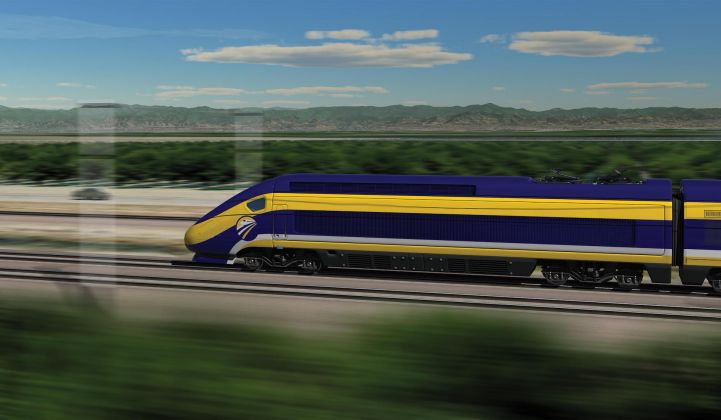During his final State of the State address, California Governor Jerry Brown took the opportunity to take a victory lap on many of the state’s accomplishments over the last eight years.
In the climate realm, he discussed the state’s cap-and-trade law, EV goals, appliance efficiency standards, and a target to reach 50 percent renewable energy by 2030. But one especially glaring project remains on the agenda: Brown’s vision for America's first electrified high-speed rail system.
“I make no bones about it: I like trains, and I like high-speed trains even better,” said Brown. “Government does what individuals can’t do, like build roads and bridges and support local bus and light-rail systems. This is our common endeavor [for] which we pool our resources through the public sector and improve all of our lives.”
Approved with a ballot measure in 2008, the 800-mile high-speed rail system would wend through the state and connect cities in the Central Valley, the Bay Area, Los Angeles, and eventually San Diego and the Inland Empire to the south and east of L.A. California plans completion of all legs by 2029 at a cost in the mid-$60-billion range -- but the project has already been snagged by a series of budget overruns, delays, legal challenges and federal grant complications.
On Thursday, Brown bypassed those dilemmas.
“Our economy, the sixth largest in the world, depends on mobility, which only a modern and efficient transportation system provides,” said Brown, adding that the train “will be fast, quiet and powered by renewable electricity, and last for 100 years -- after all of you are gone.”
Once complete -- assuming it's ever complete -- the train will run entirely on electricity produced using clean energy. According to the California High-Speed Rail Authority, the system should save 2 million to 3.2 million barrels of oil per year starting in 2030.
The electric project forms a key component of California’s ambitious climate goals. In his address, Brown noted that California’s car-driven culture means the state’s cars and heavy-duty vehicles travel upward of 330 billion miles a year.
If the rail project goes through, the state claims it will reduce trips by 10 million miles per day. In the first 58 years of operation, auto travel will decline by over 400 billion miles. Puddle-jumper flights between the state’s urban hubs could fall annually by a total of 93 to 171 flights starting in 2030. During his speech, Brown also touted California's goal to put 5 million zero-emissions cars on the state's roads by 2030.
A refurbished transportation system will be essential to keeping up with massive growth in a blossoming California, according to Brown. The state’s population has almost hit 40 million.
“That’s why we have to innovate constantly and create all manner of shelter, machines and creative technologies,” said Brown. “That will continue, but only with ever-greater public and private investment.”
Investment has been one of the biggest challenges for the train. Costly litigation and slow environmental reviews have bogged down the project, causing delays and even higher budgets. It was originally slated to cost $40 billion. But construction is underway with 1,500 workers at 17 sites, according to Brown. Many cities are already considering the rail line in current transportation plans.
“Difficulties challenge us, but they can’t discourage or stop us,” Brown said Thursday. “Whether it’s roads or trains or dams or renewable energy installations or zero-emissions cars, California is setting the pace for America.”
Despite the optimism, how soon -- or even whether -- Brown’s high-speed rail dream will have its day remains unclear. Even so, he leaves behind a strong legacy on climate action and clean energy, as well as a $6.1 billion budget surplus.
“Keep going,” Brown said, smiling, as the California legislature's joint session responded to the conclusion of his address with a standing ovation. “I’m in no hurry, no hurry to go.”




